ASSISI – Part III

In 1212, Francis brought Clare to San Damiano which became her home and that of her sisters. But who was this courageous woman who wanted to join Francis in living a life of holy poverty and self-denial?
Clare was born into a noble family of Assisi around 1193-1194. Her aristocratic ancestry can be traced to her paternal great grandfather, Paolo, from the house of the Counts of Scifi, who possessed citadels and palaces in and around Assisi. Clare’s grandfather, an only child, was called Offreduccio (the family name). He owned a large house in the wealthy area of Piazza San Rufino; in fact, it was adjacent to the Basilica of San Rufino. He had three sons, one of whom was the father of Clare, Favarone di Offreducci. He was a rich knight who employed many servants and was well known throughout the district (John Paul Kirkham, Clare of Assisi: A Light that Brightened the World).
The name of Clare’s mother was Ortolana, Countess of Sterpeto. She was a very devout woman, well known for her works of charity and practice of the spiritual life. She was much loved by the people of Assisi. She took pilgrimages to Rome and even to Jerusalem (Kirkham).
Favarone and Ortolana had 5 children: a son, Bosone, a boy and heir believed to have died early, and four daughters, Penenda, Clare, Catherine, and Beatrice.
Thomas of Celano says that while Ortolana was pregnant with her second daughter, she was praying one day before the crucifix for a safe delivery, when a voice announced to her, “Woman, have no fear. For without danger you will give birth to a light whose radiance will increase the light of day.” So when the child was born and it was time to baptize her (in the same font that witnessed the baptism of Francis), Ortolana remembered God’s comforting words and gave her the name “Chiara,” Clare, “luminous, bright,” but also in Latin (Clara), “famous.” The child was destined to become both radiant and renowned (Ivan Gobry, St. Francis of Assisi).
Ortolana, whose name means “gardener,” true to her name, cultivated the faith of her daughter by teaching her how to pray and guiding her in the ways of God by her own pious example.
Even as a girl, Clare made sacrifices by denying herself delicacies of a rich table and sending them to the orphans in the poor section of Assisi. She loved to pray and spent hours in her room in conversation with God. Under her softly tailored and rich, beautiful dresses, she wore a hair shirt as a penance. In time Clare decided to give herself to Christ alone (Kirkham).
Clare was about eleven years younger than Francis and, as a teenager, she had heard of the founding of the little community at St. Mary of the Angels. She also learned more about the new community through her cousin, Rufino, one of Francis’ first followers, and through Rufino, Francis knew about the virtues of Clare. One day Rufino came to Francis to explain that his cousin wanted to meet him. Always accompanied by her aunt, Lady Bona, Clare met with Francis a good number of times. He spoke to her about contempt for the world, about holy poverty, about being united to the sufferings of Christ crucified. The eventual result was a plan for Clare to “leave the world,” just as Francis had done nearly seven years earlier. He arranged for her to come to the Portiuncola. On Palm Sunday, of 1212, Clare, then 18 years old, attended her last family Mass at San Rufino. Bishop Guido, who was presiding and had been told by Francis what was going to happen, stepped down from the altar to the sanctuary, walked over to Clare and gave her a palm. This was a sign to Clare that he approved of her plan. During the night between Palm Sunday and Monday of Holy Week, she left her home, accompanied by her friend, Pacifica, and made her way to the Portiuncula-St. Mary of the Angels, where the friars were waiting for her in prayer before the candlelit altar. Francis cut her blond hair, and she exchanged her fine clothes for a coarse brown habit, a cord, and a black veil. Before the ceremony, as Clare later recounted, she made profession of religious obedience for life directly to Francis. It was normal at the time for those entering monastic life to make a vowed life commitment before they entered. And so there was nothing unusual about Clare’s profession, except that there was no provision for a woman to live at the Portiuncula (Augustine Thompson, OP, Francis of Assisi, a New Biography). With this ceremony, Clare became the first female Franciscan.

Francis first placed her in the Benedictine convent of San Paolo of Bastia where her family found her and tried to persuade her to change her mind, but failed. Within a couple of days, Francis moved Clare again, this time to the Benedictine nuns of Sant’Angelo of Panzo where Clare was soon joined by her 16-year-old sister, Catherine, who took the name, Sister Agnes, and was later declared a saint herself. Soon the family arrived with soldiers to take both women home by force, but again Clare succeeded in convincing her father to let them stay. Francis then arrived publicly to perform Agnes’ clothing and receive her profession of obedience. Disturbed by all the commotion, the Benedictine nuns complained to Bishop Guido, who offered Francis’ “poor ladies,” as they were called initially, their own place at the Church of San Damiano, the cradle of Francis’ conversion – the place where Christ spoke to him from the cross. It became the first convent of the female Franciscan movement. With the bishop’s protection, the women could now live in peace. Clare asked Francis to prepare for the sisters a “form of life” that must have been very similar to his own praepositum of 1209. By it, they were to “follow the perfection of the holy Gospel” (Thompson). After Clare and Agnes moved in, they began to build a cloistered community for their growing group of nuns.

Clare lived at San Damiano for 41 years, until her death on August 11, 1253. Confined to her tiny cell, cloisters, garden and chapel, Clare withdrew from the world to this place of solitude where there was silence, prayer, penance and poverty. Her mission was to pray and win souls for her beloved Lord. Very soon the fame and sanctity of Clare spread, and it was not long before the community increased. First came her childhood friends, Benvenuta from Perugia and Pacifica. Many rich young women, inspired by Clare’s holiness, gave up all to dedicate their lives to Christ. Eventually, her mother, Ortolana, her sister Beatrice, her niece, Balbina, another family member, Amata – all entered the Order of the “Poor Ladies of San Damiano.”

Clare and her sisters lived a life of poverty, austerity, and seclusion from the world. They slept on straw mattresses, fasted regularly, did not eat meat, and often did penance. They woke up in the middle of the night to pray the Divine Office. They went barefoot on stone floors, and observed almost complete silence. The year 1224 marks the beginning of Clare’s severe illness.
Over the years, prelates tried to draw up a rule for the Poor Ladies based primarily on the Rule of St. Benedict, but Clare continued to defend their call to live a life of absolute poverty and wanted to include in their rule the Privilege of Poverty, that is, to own nothing in this world and to depend completely on the providence of God.
To Agnes of Prague (daughter of the King of Bohemia and founder of a monastery of Poor Ladies in Prague), Clare wrote a letter in which she speaks about contemplation: “Place your mind before the mirror of eternity! Place your soul in the brilliance of glory! Place your heart in the figure of the divine substance! And transform your entire being into the image of the Godhead Itself through contemplation” (Third Letter, 12, 13).
Reflection: Let me contemplate the words of Clare to Agnes of Prague.
Many miracles are attributed to Clare: Once in September 1240, Saracens were attacking the walls of San Damiano on their way to the city. Clare commanded her sisters to lead her, although she was very sick, to the enemy, preceded by a monstrance in which Our Lord was kept with great devotion. She prayed before the Blessed Sacrament for the safety of the sisters, and suddenly the Saracens retreated for no explainable reason.

In June of 1241, invading troops of Vitalis d’Averso were attacking Assisi. Again, her prayers before the Blessed Sacrament spared the city.
On Christmas Eve in 1252, just one year before her death, Clare was not well enough to attend Mass with her sisters and the friars at the new Basilica of St. Francis. As she began to meditate on the Mystery of Christmas, suddenly her room burst into light, and she could see the Mass on the wall of the dormitory. Her vision was so clear that she could name the friars who were there. She watched the celebrant ascend the altar and participated at the Mass listening to the beautiful chants. Because of this miracle, Clare was named patroness of television.

Dormitory of St. Clare at San Damiano
Her spirituality can be summarized by these few words: lover of the Eucharist, blessed poverty, holy humility, and ineffable charity.
Pope Innocent IV approved the Franciscan Rule for women with the Privilege of Poverty just before Clare died in 1253. Only two years later, Clare was canonized. Just ten years after her death her Sisters were called Poor Clares.
Reflection: How am I witnessing to evangelical poverty in the 21st century? How do I live separation from the world proper to the character and purpose of my religious institute?
Strangely, from 1209, when Francis had prepared a “form of life” for the sisters, except for an exchange of letters, Clare completely disappears from Francis’ life. It was not until his last illness that Francis returned to San Damiano once more.
During his travels to Egypt in 1219 to convert the Sultan, Francis’ eyes had been damaged by the strong sun. On September 14, in 1224 he had received the Stigmata on Mount La Verna (see Part II), and now in 1225, he came back to San Damiano to see his sisters. He stayed in the gardens in a darkened hut, since he had an aversion to light, and there Clare took care of him. For about three months, he remained in absolute darkness, with headaches and burning in his eyes, combined with the pain from his stigmata. In this condition, Francis composed one of the most exalting hymns of joy and praise to God. It was written in the Italian vernacular. It is, of course, “The Canticle of the Creatures.” Francis took as his basis for its composition the Canticle of Daniel from the Old Testament and simplified it. His brothers and sisters sang it every day.

Francis, “sitting down began to meditate and then said: ‘Most High, all-powerful, good Lord…’” Francis himself gives us the key to interpreting the canticle: “I want to compose a new praise of the Lord regarding His creatures.” Francis was enchanted by the beauty and goodness of creatures, because they were the mirror of the beauty of God, a sign and an instrument of the love of the “Most High, all-powerful, good Lord.” The canticle also reflects Francis’ sense that all creation, sun, moon, earth, wind, water, fire, all creation points to God. It is a wonderful summary of Francis’ relationship with the created world, one founded on the discovery of God as His Father, and not his alone but everyone’s.

Stained glass windows of St. Care (left) and St. Francis (right)
On October 3, 1226, surrounded by his brothers and Lady Jacoba, his longtime friend, Francis died at the Portiuncula at the age of 44 and his last words were: “I have done my part, may Christ teach you yours.”

On the morning of October 4th, they carried the body of Francis on a stretcher up to the town of Assisi for burial in the Church of St. George, with his brothers and members of the clergy singing hymns, saying psalms and bearing torches. On their way, they stopped at San Damiano so that Clare and her sisters could bid their farewell.

Giotto’s fresco of the body of Francis carried to Assisi
His body was kept in the Church of San Giorgio from 1226 until 1230 while Brother Elias, the Vice Minister General, oversaw the building of the new basilica to house the tomb of Francis (Lucinda Vardey, Traveling with the Saints in Italy).
The ancient Church of St. George was built ca. 1111. It was in this church that Francis attended school and learned to read, and here, after his conversion, he used to preach. Francis was canonized in the Church of St. George in 1228.
The early Gothic-style Basilica of St. Clare was built on the site of the Church of St. George, which was then outside the walls of Assisi. The body of St. Clare was brought to the Church of St. George from San Damiano after her death in 1253, and some sisters moved here at that time to be near her tomb. Construction of her basilica was begun in 1257. In 1260, the Bishops of Perugia, Spoleto and Assisi transferred the relics of St. Clare from St. George to a burial vault under the high altar of the new church.

Basilica of St. Clare on the site of the Church of St. George
On the exterior, the “flying buttresses” were added at the end of the 14th century. The exterior of the building is designed of alternating strips of pink and white limestone from the quarries of Monte Subasio and is recognizable from great distances. St. Clare’s bell tower is the tallest in Assisi.
The interior of the basilica is a smaller replica of the upper church of the Basilica of St. Francis. It has a single nave (aisle) which ends in a transept and a many-sided apse and contains a crucifix dating from before 1260 hanging above the choir.
On the right-hand side of the nave is the Chapel of the Crucifix and the Chapel of the Sacrament. Both were once part of the nave that belonged to the Church of St. George, where Pope Gregory IX canonized Francis in 1228.
The wooden Crucifix in the Chapel of the Crucifix is the famous 12th century “St. Damiano Crucifix,” the one that spoke to Francis, asking him to repair His Church. The nuns brought the precious San Damiano Crucifix with them when they moved from San Damiano to St. George. The Chapel of the Crucifix contains frescoes dating from the 13th to the 15th centuries.
Let us go down into the crypt, which was built between 1850 and 1872 in the Neo-Gothic style. It was restored in 1935. The east end contains the body of St. Clare. When the new basilica was completed in 1260, her remains were buried deep beneath the high altar. For about six centuries, the body of Clare lay buried. In 1850 Pope Pius IX gave permission to excavate in order to find the body of St. Clare. After seven days, the stone coffin containing her body was found. When it was opened, it was discovered that St. Clare’s body was still incorrupt, but blackened with age. She had been buried with her poor tunic and the rule that she had written. Her remains were put into a crystal coffin and placed in a new crypt within the basilica. In time, St. Clare’s body began to deteriorate. So, a mask of dark leather was made in 1850 to cover her remains, which were soon reduced to bones. In the last restoration, an entire new head was made digitally in wax to correspond with her bone structure. This is the face of Clare seen today in the picture below (Bret Thoman).

Body of St. Clare
At the west end of the crypt, some important Franciscan relics are displayed behind a modern grille: tunics worn by Francis and Clare, a shirt embroidered by Clare, and some golden locks of Clare’s hair cut by Francis.
Eremo delle Carceri: The Hermitage of the Prisons on Monte Subasio
While we are on the east side of Assisi, let us exit the town by way of the Porta Cappuccini and climb to the Hermitage of the Prisons (Carceri) on Monte Subasio. It is a five-mile trek which makes it an hour’s walk or 15 minutes by car. The sense of the word Carceri or “prisons” is that of a “solitary place,” rather than that of a place of confinement.
We learn from the author of The Little Flowers, XVI that Francis retreated to the Hermitage after his conversion. It was a time when Francis was wondering what he ought to do, whether to pray only or whether to preach occasionally. He knew only that he wanted above all to do the Will of God. So he asked Brother Silvestro and Clare to help him discern. Their response was “that God had not called him to this state only for himself, but in order that he bear much fruit in the souls of others, and that many should be saved through him.”
Francis obeyed their counsel and became an ardent evangelist and missionary. Both Francis and Dominic are founders of “mendicant” orders, adopting a lifestyle of poverty, traveling, and living in city settings for the purpose of preaching, evangelization and ministry to the poor. Until this time, there was only the monastic model, by which members live in one stable community, work at a trade, and own land and buildings.
Still Francis retained the soul of a hermit. In every region that he preached, he sought a solitary retreat for prayer (e.g. Fonte Colombo, La Verna, Montecasale in Sansepolcro). But in Assisi, his favorite retreat was the Hermitage of the Carceri.
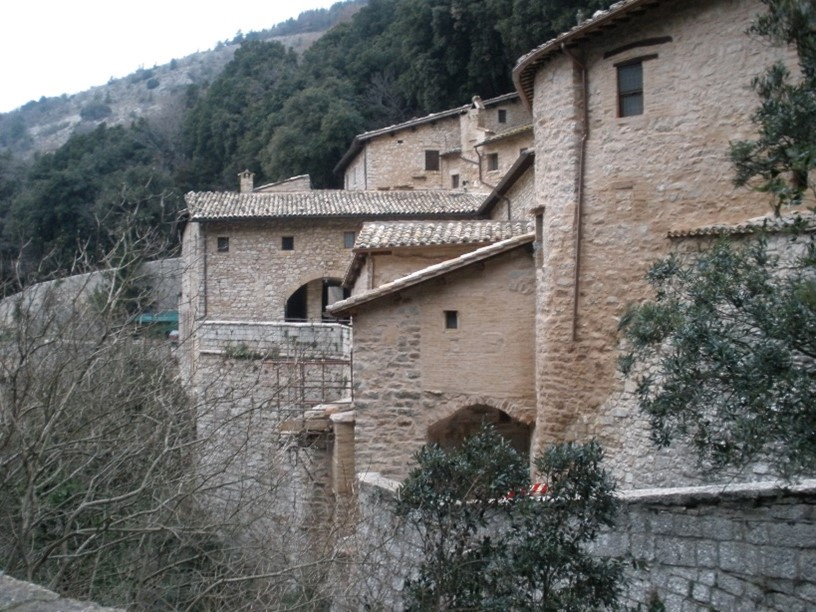
Finally, it is time to make our way to the west side of Assisi to see the Sacro Convento (the Franciscan Friary) and the Upper and Lower Basilicas of St. Francis. The upper church in the soaring Italian Gothic style, displays on the two walls of the nave Giotto’s major work: the life of St. Francis in 28 tableaux. In the lower church we will see frescoes painted by many artists, including Cimabue, Simone Martini, Pietro Lorenzetti, and the students of Giotto. Beneath the lower church, we will descend later to the crypt, built in the 19th century, where we can venerate the tomb of St. Francis.
With that general description, let me begin from the beginning. Almost two years after his death on October 3, 1226, Francis was declared a saint by Pope Gregory IX on July 16, 1228. On the following day, he blessed and laid the cornerstone for the basilica, which would be built outside the city walls, on the spot known as the ‘Hill of Hell” where previously criminals were put to death. It would soon become known as the “Hill of Paradise” because Francis’ body, temporarily kept in the Church of St. George, was to be transferred there. The lower church was completed in 1230. On May 25, 1230, the body of the saint was brought in a solemn procession to the lower church and embedded in a stone sarcophagus in the solid rock beneath the main altar. The place of burial was concealed for fear that the saint’s remains would be stolen and dispersed. The lower church was structurally a large crypt constructed beneath the basilica. The construction of the upper church was not begun until in 1239 and completed in 1253, the year both churches were consecrated. In 1818, the remains of St. Francis were rediscovered beneath the floor of the lower church. In the reign of Pope Pius VII in the 19th century, a lower crypt, a third level, was constructed beneath the lower church and placed there so that the faithful could visit the tomb of St. Francis.
The designer of the double basilica was Jacopo Tedesco. The “job manager” was Brother Elias, one of the first followers of St. Francis and the Vice Minister General under Francis.
The idea of building a basilica was that of Pope Gregory IX. He decided to construct two monuments to Francis. The first was a literary one: he commissioned Thomas of Celano to write the life of St. Francis, the Vita Prima, which he finished in 1228. The second monument was the basilica, under the supervision of Brother Elias. Since the construction was begun at his order, the Pope declared the church to be the property of the papacy, but the “head and mother” of the Franciscan Order. It is a Papal minor basilica and a plenary indulgence can be obtained by visiting it according to church norms. It is one of the most important and popular places of Christian pilgrimage in Italy.
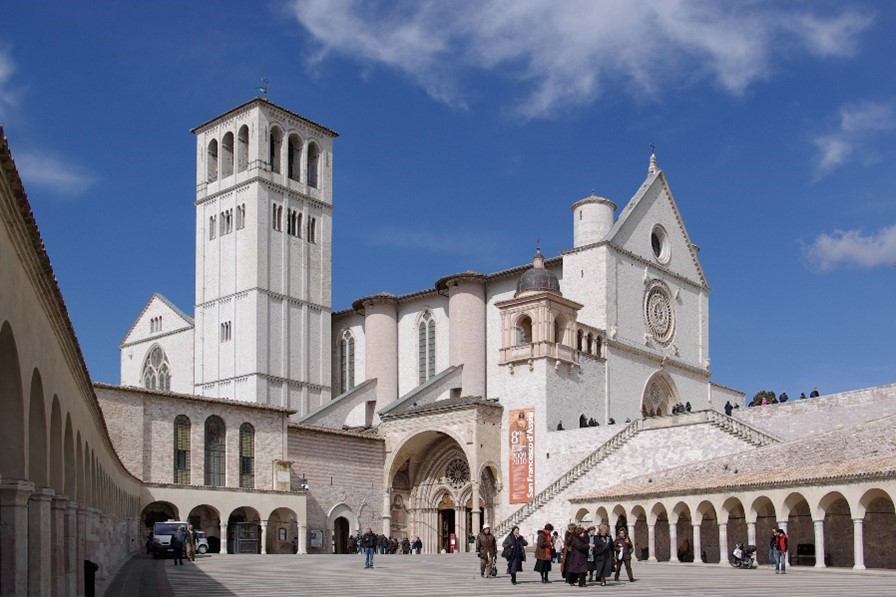
Lower Basilica and colonnades (1474) to house pilgrims
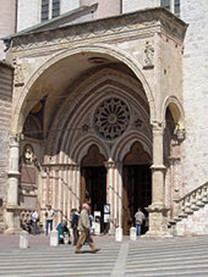
Lower Basilica
The architecture of the two basilicas (churches) is very different. The architecture is a synthesis of the Romanesque and Gothic styles. Originally both upper and lower churches were supposed to have the form of a tau cross, so dear to St. Francis.
The lower church was built mainly in the Romanesque style. Exterior: The entrance is through a decorated Gothic doorway built between 1280 and 1300. Set in the tympanum of the doorway is an ornate rose window. Before we enter, I want to point out that over the doorway are the words granting a daily plenary indulgence.
Interior: Clearly in the Romanesque style are the semi-circular ribbed cross-vaults over the nave and barrel vaults over the side arms (transepts). Over the altar we see four allegorical paintings set into four sections of the vault, depicting the Glory of Francis and the three vows of poverty, chastity and obedience, now attributed to a pupil of Giotto. The main decorative feature of Italian church architecture and the main medium of conveying the Church’s message is fresco rather than stained glass windows. Here in the lower church we see some of the earliest.
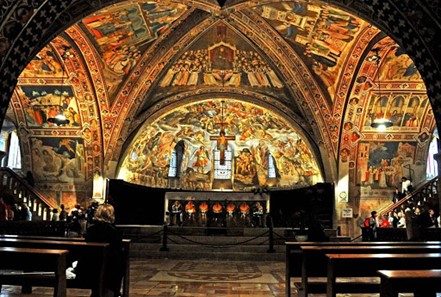
Lower church: altar, apse, vault, and left and right transepts
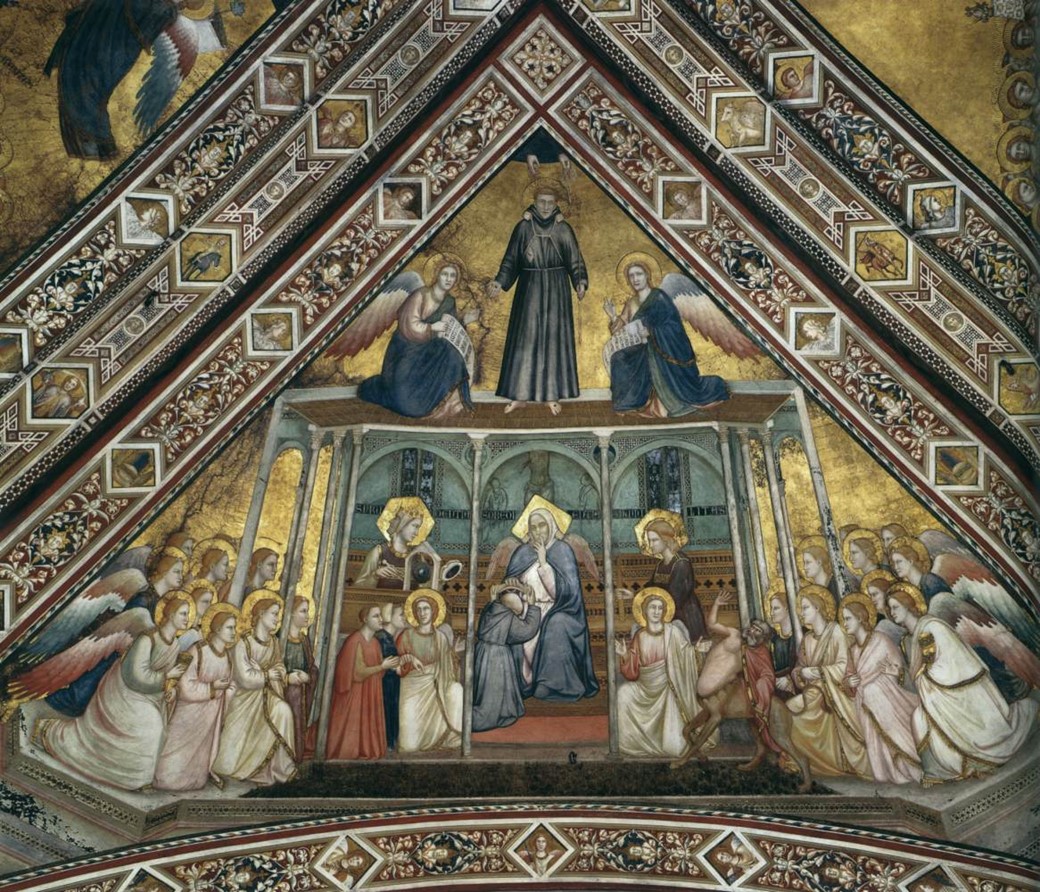
Allegory of Obedience
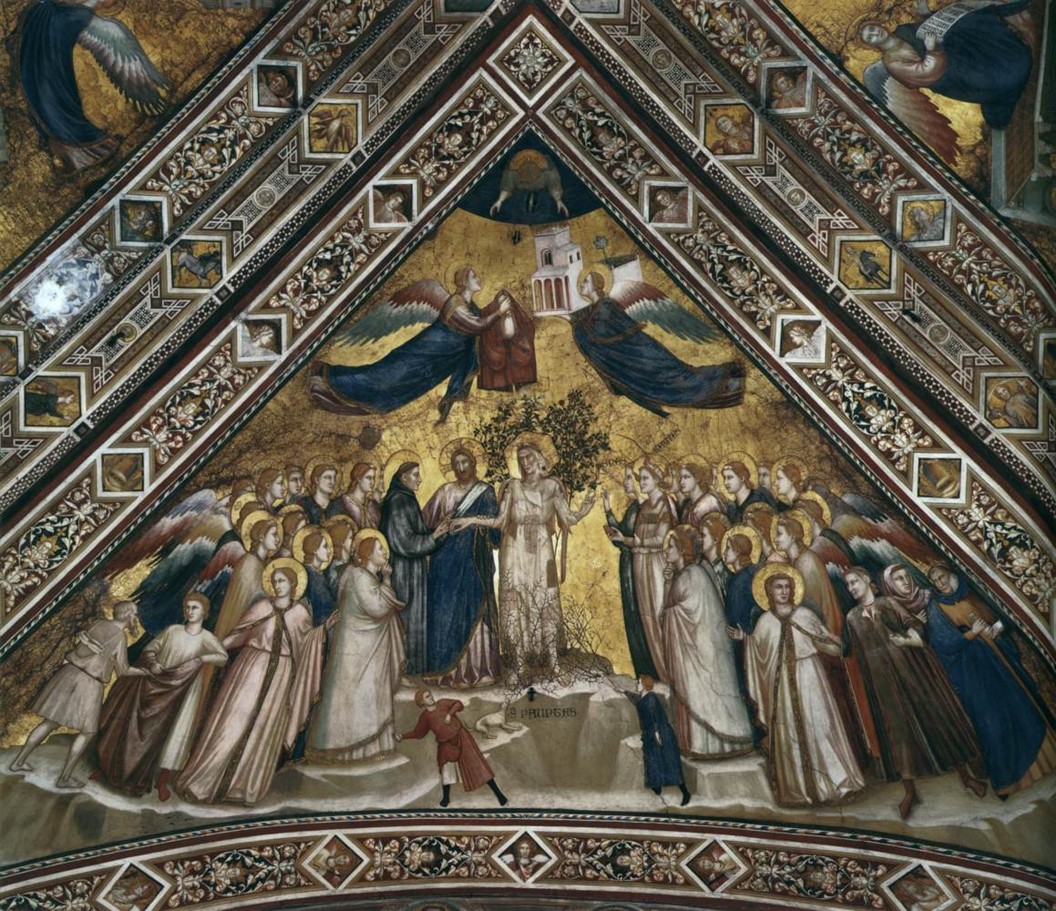
Allegory of Poverty
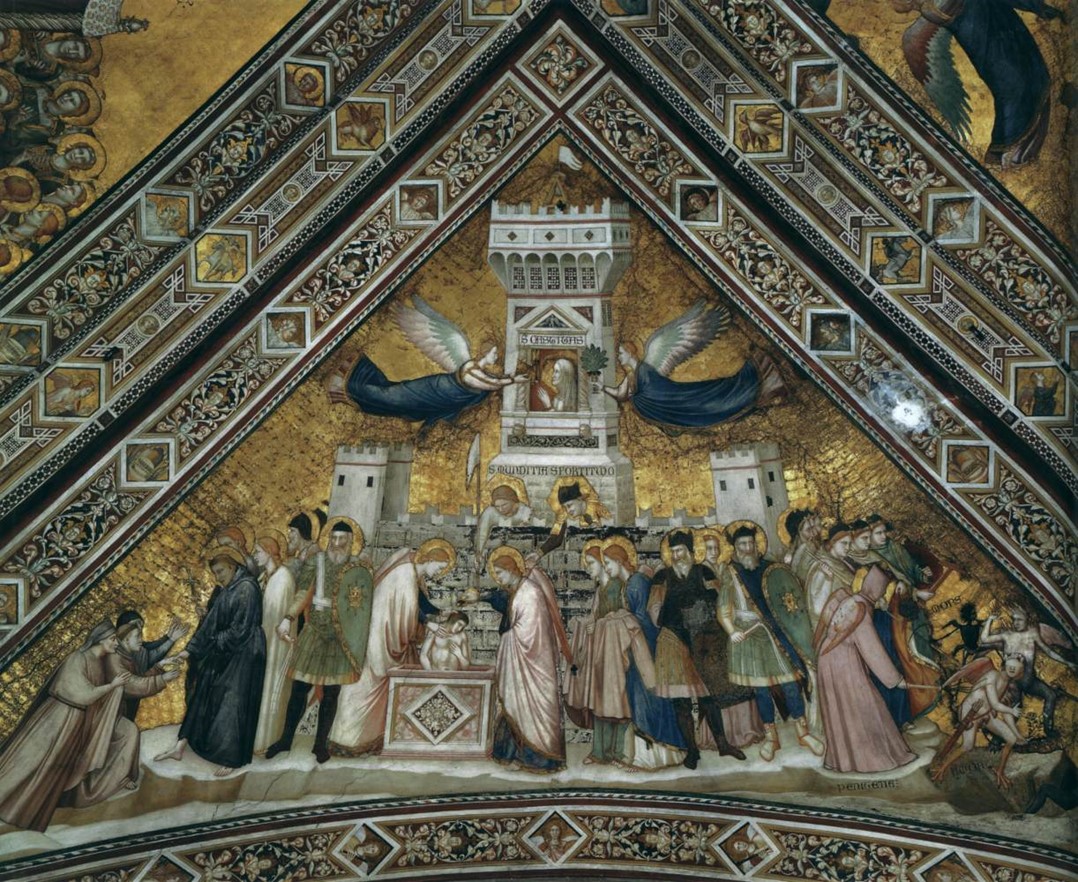
Allegory of Chastity
Reflection: How would I explain my vows to a young woman discerning religious life after reflecting on these frescoes?
On the left transept, there are frescoes featuring scenes from the Passion of Christ and five scenes from the Life of Francis. By this juxtaposition, the Franciscans wanted to convey the idea that their founder is an “alter Christus.”
Reflection: In following Christ in religious life, is it enough only to serve Him or does it also mean becoming like Him?
Frescoes in the right transept depict the childhood of Christ, partly by Giotto and his workshop. The Nativity is the work of the anonymous Maestro di San Nicola. The frescoes by Giotto were revolutionary in their time, showing angels and real people with emotions.
On the right transept wall Cimabue (1280) painted the image of Our Lady enthroned among Angels and St. Francis. Cimabue’s fresco corresponds to the physical description of Francis by his first biographer, Thomas of Celano. It may be the nearest likeness to Francis that exists, though some will say that the Subiaco portrait is also very close to real.

Cimabue: Our Lady Enthroned among Angels and St. Francis
Reflection: What is the artist saying by placing Francis next to the throne of Mary? Where would I place myself in this fresco?
Still on the right transept, Simone Martini (ca. 1317) painted frescoes of eight figures of saints, of which we see three here below. They are traditionally thought to be St. Elizabeth of Hungary, St. Clare and St. Eleazar. Characteristics of Sienese painting are the aristocratic features of the figures, almond-shaped eyes, harmonious lines.
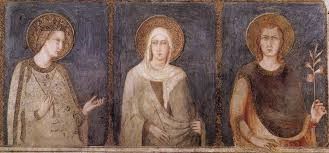
Martini: St. Elizabeth of Hungary, St. Clare, St. Eleazar
The left transept of the lower church was painted by the Sienese painter Pietro Lorenzetti and his workshop between 1325 and 1330. There are depicted here six scenes from the Passion of Christ. The fresco of the Deposition of the Cross is especially sorrowful and filled with emotion.

Lorenzetti: The Deposition of the Cross
Reflection: How do I imagine the deposition of Christ from the Cross?
Beneath the great “Crucifixion” scene is Lorenzetti’s fresco of the Madonna and Child accompanied by St. John the Evangelist and St. Francis. It is called “Madonna of the Sunset” because at sunset, the image is illuminated by the rays of the sun filtering through the window that faces it. The Franciscans tell the story that in this fresco Jesus is asking Mary which of these two saints is her favorite. Without a word, she responds!

Lorenzetti: Our Lady of the Sunset
There is so much more to see in the lower church, side chapels, stained glass windows, ornate doors, and more frescoes, but we will save the rest for the time you come to Assisi.
Let us ascend to the upper church.

Exterior: The façade of the upper church is extremely simple with a minimum of architectural elements conveying the idea of Franciscan simplicity and serving as an entrance for the artistic and spiritual treasures to be found inside. In its basic lines and in the rose window, the façade is Romanesque. It is Gothic in its two French-style doors. The result is a beautiful architectural whole balanced in the pink and white stone of Monte Subasio. The façade is divided into three parts. The intermediate level is rectangular in form. In the center is a rose window in Cosmati work and is supported by the symbols of the evangelists: the man/angel for St. Matthew; the ox for St. Luke; the lion for St. Mark; and the eagle for St. John. The upper level is triangular in form with a small oculus (eye) in the center. To the left of the Basilica is a free-standing bell tower of Romanesque design. Attached to the left of the façade is the Benediction Loggia which is topped by a hemispherical dome.

Nave of upper church
Interior: Whereas the lower church is dark, the upper church is bright and spacious. The style of the upper church is French Gothic with a single nave divided into four sections. All of the walls of the upper church are covered with frescoes. In the nave, the lower register contains the famous Giotto cycle (1295-1300) dedicated to St. Francis. Giotto di Bondone, a Florentine artist, trained by Cimabue, used the Legenda Maior, the biography of St. Francis by St. Bonaventure (1266) to reconstruct the major events in the life of the saint in a series of 28 frescoes. From the point of view of religion, Bonaventure’s interpretation of the life of the Poverello is evident in the triple aspect of love for God, love for man and for His creatures. This is evident in the frescoes of Giotto. From the point of view of art, Giotto initiated innovative aspects: three-dimensionality of the image, the inclusion of landscape, the way in which figures become living beings. He was aided in these frescoes by his disciples and by some older painters. Here are just a few.

Francis returns clothing to his father

Innocent III sees in dream Francis sustaining the church

Francis makes the first Christmas crib scene at Greccio
In recent years, scholars have tried to relate the 28 frescoes of the life of St. Francis to the 34 frescoes in the upper zone of the nave of the upper church (16 scenes from the Old Testament and 18 scenes from the New Testament) recreating a closer parallel between the story of salvation and the life of Francis. The result is a wonderful catechesis. The figure of Francis reflects both the Old and the New Testament.
The apse and the transept of the upper church were painted by the Florentine artist, Cimabue (1240-1300). The colors have changed but it remains the highest example of his art. The right arm of the transept is frescoed with Scenes from the Acts of the Apostles concerning St. Peter and St. Paul; a Crucifixion and, above it, the Transfiguration and Christ in Glory.
The left arm of the transept contains scenes from the Apocalypse, and, behind the altar, the large scene of the Crucifixion. The use of a lead-based paint which has deteriorated has given this fresco the appearance of a photographic negative. Nevertheless, the imposing scene of the Crucifixion remains very dramatic. Above, we see the weeping angels flying around Christ crucified, receiving His blood in a chalice. Below, there are two groups of figures with opposing feelings: some in favor, some against Christ. At the foot of the cross is St. Francis.

Left arm of transept is on our right side
Let’s go back to the nave, the central aisle. The upper part of the nave on both sides was badly damaged by the earthquake of 1997. That day two earthquakes hit the Umbrian area of Italy in rapid succession. Many buildings were destroyed or damaged. While a group of specialists and friars were inspecting the damage to the Basilica of St. Francis, an aftershock shook the building, causing the collapse of the vault. Two Franciscan friars, one 48 years old, the other 25 years old, who were among the group, and two specialists were killed. The Franciscans had been near the main altar when they tried to run for cover. Fortunately, not more were killed since there were twenty people in the basilica at that time. Much of the frescoes of the Life of St. Francis by Giotto were damaged and those of the sections of the vault which collapsed were almost entirely destroyed. The basilica was closed for restoration for two years.
In the upper church of the Basilica, on October 10, 2020, the beatification ceremony of Blessed Carlo Acutis took place with Cardinal Agostino Vallini presiding on behalf of Pope Francis. Blessed Carlo was buried at his request in Assisi in 2006 because of his love for St. Francis. Like his chosen patron, he had a special bond with the poor and homeless.
Let us go now to the Crypt, the lowest level of the Basilica. There we find the burial place of St. Francis above the altar. We remember that Brother Elias had hidden the saint’s remains down deep under the high altar of the lower church in 1230 for fear of theft. In 1818, after 52 nights of searching, a stone sarcophagus was found surrounded by a metal grate, set in rock, and protected by layers of concrete. The remains were found in skeletal condition but generally well-preserved. Pope Pius VII declared that this was indeed the body of St. Francis and ordered the venerable body not to be taken from the place in which it had been for almost six centuries and that the entire sepulcher be beautified and that a more suitable entrance be opened.

In 1978 Pope Paul VI made a re-examination of the data and provided for an improved method of preserving the body f St. Francis. It is now in a small plexiglass casket, enclosed in the metal casket of 1820, placed in the original stone coffin in which the body was laid in the 13th century. This is what we see now above and behind the altar.
Four of the first companions of St. Francis are buried around the tomb: Masseo, Angelo, Rufino, and Leo.
On the anniversary of the death of St. Francis, October 3, 2020, Pope Francis signed a new encyclical, “Fratelli tutti” before the tomb of St. Francis. The subject of the encyclical is fraternity and social friendship and was inspired by St. Francis, as was “Lodato sì” on the care of our common home.
An urn with the remains of Lady Jacopa dei Settesoli was placed at the entrance of the crypt in 1933. Francis called her “Frate (Brother) Jacopa.”


Sacro Convento and Basilica
Sacro Convento: Right next to the Basilica stands the Sacro Convento, the Franciscan friary, with its imposing walls supported by 53 Romanesque arches and buttresses. It was built with the pink and white stone from Monte Subasio. While it was inhabited by the friars as early as 1230, it took a long time to complete due to the different styles: Romanesque intermingled with the Gothic style.
The General Custody of the Sacred Convent is made up of about sixty friars. The friars belong to the Order of Friars Minor Conventual which lives the Rule of St. Francis. The Sacred Convent, defined as “the head and mother” of the Order, gathers friars who come from all over the world to live fraternity where the charism originated and where lie the remains of St. Francis. Friars come to Assisi for various commitments and activities, and the youngest friars come from various parts of Italy and Europe for a year of novitiate to prepare to profess religious vows before returning to their places of origin.
The friary now houses a vast library with medieval codices and incunabula (books printed using metal type), a museum with works of art donated by pilgrims throughout the centuries, and 57 works of art of the Perkins collection.
Reflection: Would St. Francis have approved of such a church for his remains given his desire to live and to preach poverty?
My response would be that he would not approve. But Francis would be happy about this one fact: The Franciscans do not own the basilica; rather, they simply take care of it. We cannot deny that countless pilgrims throughout nine centuries have benefitted spiritually from their visit to this beautiful and inspirational house of God. In fact, the superb works of art here express in images the life and spirit of Francis.
Reflection: Saint John Paul II came to Assisi for the first time as Pope on November 5, 1978, twenty days after being elected Supreme Pontiff. In his address in the Basilica of St. Francis, he said: “The Pope, who, owing to his mission, must have before his eyes the whole universal Church, the bride of Christ, in the various parts of the globe, particularly the needs the help of the Patron Saint of Italy (Francis) in his See in Rome; he needs the intercession of St. Francis of Assisi. So he arrives here today. He comes to visit this city, which is always a witness to the marvelous divine adventure that took place between the end of the 12th and beginning of the 13th century. It is a witness to that surprising holiness that passed here like a great breath of the Spirit. A breath in which St. Francis of Assisi participated, as well as his spiritual sister St. Clare…
As a virtual pilgrim, could I sense in some way the” breath of the Spirit” in which Francis participated and which still lingers as I traveled virtually through the city of the Poverello?
What favors would I seek through the intercession of St. Francis or St. Clare?
What elements of Franciscan spirituality are highlighted in the works of art in the Basilica?
On October 27, 1986, Saint Pope John Paul II convened representatives of the world’s religions to gather at the Church of Saint Francis of Assisi, Italy to pray together for the first time in history.
Thirty-five years ago at the closing of the first Assisi World Day of Prayer, Saint Pope John Paul II remarked:
“For the first time in history, we have come together from everywhere, Christian Churches and Ecclesial Communities, and World Religions, in this sacred place dedicated to Saint Francis, to witness before the world, each according to his own conviction, about the transcendent quality of peace. The form and content of our prayers are very different, as we have seen, and there can be no question of reducing them to a kind of common denominator. Yes, in this very difference we have perhaps discovered anew that, regarding the problem of peace and its relation to religious commitment, there is something which binds us together…”
Reflection: What makes Assisi a City of Peace and Francis an apostle of Peace?
End of PART III. Please go to the CONCLUSION.
